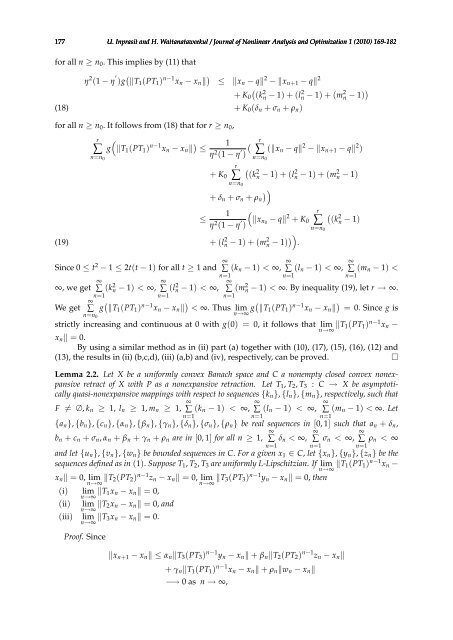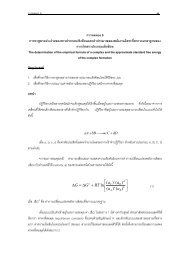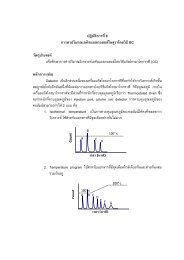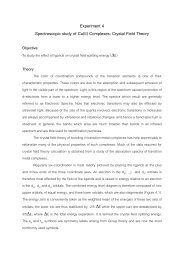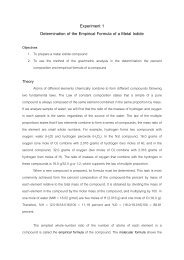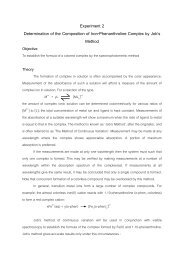Common Fixed Points of a New Three-Step Iteration with Errors of ...
Common Fixed Points of a New Three-Step Iteration with Errors of ...
Common Fixed Points of a New Three-Step Iteration with Errors of ...
You also want an ePaper? Increase the reach of your titles
YUMPU automatically turns print PDFs into web optimized ePapers that Google loves.
177 U. Inprasit and H. Wattanataweekul / Journal <strong>of</strong> Nonlinear Analysis and Optimization 1 (2010) 169-182<br />
for all n ≥ n 0 . This implies by (11) that<br />
(18)<br />
η 2 (1 − η ′ )g ( ‖T 1 (PT 1 ) n−1 x n − x n ‖ ) ≤ ‖x n − q‖ 2 − ‖x n+1 − q‖ 2<br />
+ K 0<br />
(<br />
(k<br />
2<br />
n − 1) + (l 2 n − 1) + (m 2 n − 1) )<br />
+ K 0 (δ n + σ n + ρ n )<br />
for all n ≥ n 0 . It follows from (18) that for r ≥ n 0 ,<br />
(19)<br />
r (<br />
∑ g ‖T 1 (PT 1 ) n−1 x n − x n ‖ ) ≤<br />
n=n 0<br />
≤<br />
1 ( r<br />
η 2 (1 − η ′ )<br />
∑ (‖x n − q‖ 2 − ‖x n+1 − q‖ 2 )<br />
n=n 0<br />
+ K 0<br />
r<br />
∑<br />
n=n 0<br />
(<br />
(k<br />
2<br />
n − 1) + (l 2 n − 1) + (m 2 n − 1)<br />
+ δ n + σ n + ρ n<br />
) )<br />
1<br />
(‖x<br />
η 2 (1 − η ′ n0 − q‖ 2 r (<br />
+ K 0<br />
)<br />
∑ (k<br />
2<br />
n − 1)<br />
n=n 0<br />
+ (l 2 n − 1) + (m 2 n − 1) )) .<br />
Since 0 ≤ t 2 − 1 ≤ 2t(t − 1) for all t ≥ 1 and ∑<br />
∞ (k n − 1) < ∞,<br />
∞, we get<br />
∞<br />
∑<br />
n=1<br />
∞<br />
∑<br />
(k 2 n − 1) < ∞,<br />
∞<br />
∑<br />
n=1<br />
(l 2 n − 1) < ∞,<br />
n=1<br />
∞<br />
∑<br />
n=1<br />
(l n − 1) < ∞,<br />
∞<br />
∑ (m n − 1) <<br />
n=1<br />
∞<br />
∑ (m 2 n − 1) < ∞. By inequality (19), let r → ∞.<br />
n=1<br />
We get g ( ‖T 1 (PT 1 ) n−1 x n − x n ‖ ) < ∞. Thus lim g ( ‖T 1 (PT 1 ) n−1 x n − x n ‖ ) = 0. Since g is<br />
n=n 0 n→∞<br />
strictly increasing and continuous at 0 <strong>with</strong> g(0) = 0, it follows that lim ‖T 1 (PT 1 ) n−1 x n −<br />
n→∞<br />
x n ‖ = 0.<br />
By using a similar method as in (ii) part (a) together <strong>with</strong> (10), (17), (15), (16), (12) and<br />
(13), the results in (ii) (b,c,d), (iii) (a,b) and (iv), respectively, can be proved. □<br />
Lemma 2.2. Let X be a uniformly convex Banach space and C a nonempty closed convex nonexpansive<br />
retract <strong>of</strong> X <strong>with</strong> P as a nonexpansive retraction. Let T 1 , T 2 , T 3 : C → X be asymptotically<br />
quasi-nonexpansive mappings <strong>with</strong> respect to sequences {k n }, {l n }, {m n }, respectively, such that<br />
∞<br />
∞<br />
∞<br />
F ̸= ∅, k n ≥ 1, l n ≥ 1, m n ≥ 1, ∑ (k n − 1) < ∞, ∑ (l n − 1) < ∞, ∑ (m n − 1) < ∞. Let<br />
n=1<br />
n=1<br />
n=1<br />
{a n }, {b n }, {c n }, {α n }, {β n }, {γ n }, {δ n }, {σ n }, {ρ n } be real sequences in [0, 1] such that a n + δ n ,<br />
b n + c n + σ n , α n + β n + γ n + ρ n are in [0, 1] for all n ≥ 1,<br />
∞<br />
∑ δ n < ∞,<br />
n=1<br />
∞<br />
∑<br />
n=1<br />
σ n < ∞,<br />
∞<br />
∑<br />
n=1<br />
ρ n < ∞<br />
and let {u n }, {v n }, {w n } be bounded sequences in C. For a given x 1 ∈ C, let {x n }, {y n }, {z n } be the<br />
sequences defined as in (1). Suppose T 1 , T 2 , T 3 are uniformly L-Lipschitzian. If lim ‖T 1 (PT 1 ) n−1 x n −<br />
n→∞<br />
x n ‖ = 0, lim ‖T 2 (PT 2 ) n−1 z n − x n ‖ = 0, lim ‖T 3 (PT 3 ) n−1 y n − x n ‖ = 0, then<br />
n→∞ n→∞<br />
(i)<br />
(ii)<br />
(iii)<br />
lim ‖T 1 x n − x n ‖ = 0,<br />
n→∞<br />
lim ‖T 2 x n − x n ‖ = 0, and<br />
n→∞<br />
lim ‖T 3 x n − x n ‖ = 0.<br />
n→∞<br />
Pro<strong>of</strong>. Since<br />
‖x n+1 − x n ‖ ≤ α n ‖T 3 (PT 3 ) n−1 y n − x n ‖ + β n ‖T 2 (PT 2 ) n−1 z n − x n ‖<br />
+ γ n ‖T 1 (PT 1 ) n−1 x n − x n ‖ + ρ n ‖w n − x n ‖<br />
−→ 0 as n → ∞,


